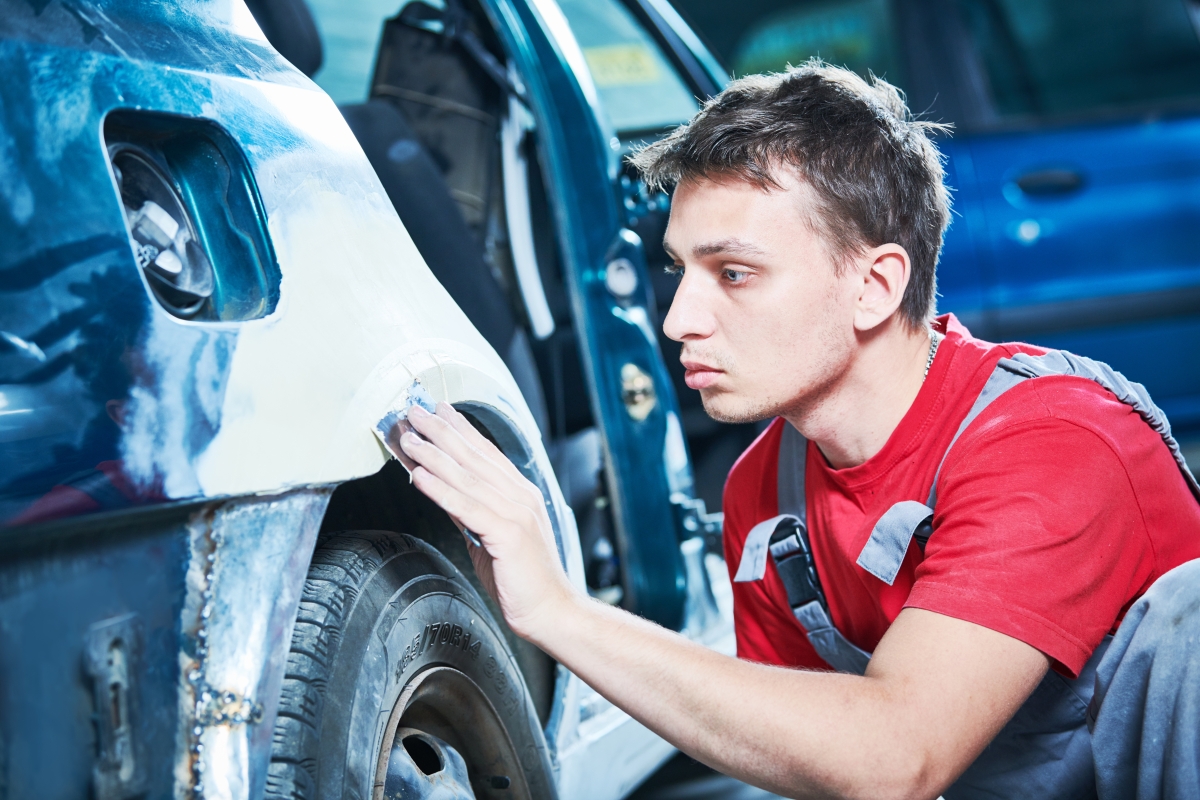Career Overview
Auto body collision, refinishing and glass technicians and damage repair estimators fix and restore motor vehicle body parts, interior finishing, repaint automotive body surfaces and repair/replace automotive glass. This occupational group also includes metal repairers, who fix defective automobile body parts and damage on newly assembled cars.
Job Titles
Duties
In general, motor vehicle body repairers:
- Read damage reports and cost estimates, and plan work to be done
- Repair and replace vehicle front end and other body surfaces including doors, frames and underbody components
- Hammer out dents, buckles and defects using blocks and hammers
- Operate soldering equipment or use plastic filler to fix holes, dents and seams
- Remove damaged fenders, panels and grills using wrenches and cutting torches
- Bolt or weld replacement parts into place
- Straighten bent frames using frame and underbody pulling and anchoring equipment
- File, grind and sand repaired body surfaces using hand and power tools
- Mask and tape auto body surfaces in preparation for painting
- Mix paint, blend and match colours
- Apply primers and repaint surfaces using brush or spray guns
- Repair and replace glass, such as windshields, windows and sunroofs
- Check repaired vehicles to make sure they work properly
Motor vehicle body repairers may also:
- Repair/replace interior surfaces, such as seat frame construction, carpets and floorboard insulation
- Remove components during repairs to access the damage
- Align and replace steering and suspension sections
- Work with mechanical and electronic elements, such as air conditioning and exhaust systems as well as with passenger restraint systems, such as air bags and set belts
Earnings
Earnings is income that workers receive in exchange for their labour. Depending on the type of employment, earnings can be in the form of wages (hourly), salaries (fixed monthly or annual) or self-employed earnings.
Work Environment
# Workers Employed
4,225% Employed Full Time
63%Motor vehicle body repairers usually work 35 to 40 hours a week, with some occasional overtime. Work is typically done indoors in repair shops, which can be noisy and dusty.
This work can be physically difficult and is often done in small and uncomfortable spaces. Health risks include cuts from sharp metal, burns from torches and heated metal, injuries from power tools and fumes from paint. Most shops have dust removal equipment and use paints that are low odour to help reduce these issues. Health and safety rules/regulations must be followed to limit risks to workers.
Career Pathways
Motor vehicle body repairers often start their careers in junior positions, such as shop hands. Most graduates start apprenticeships once they have completed a collision repair course.
Experienced workers may progress to supervisory positions or start their own businesses.
Metal repairers may move into motor vehicle repairer positions by completing an apprenticeship program. With experience, they may move to supervisory positions in motor vehicle manufacturing.
Occupational Interests
It’s important to understand what kinds of occupations align with your interests.
For more about occupational interests visit Skills for the Future Workforce > Characteristics.
Here are the top occupational interest(s) for this career profile:
Education, Training and Skills
At minimum, completion of Grade 10 or the equivalent (including English 10, Mathematics 10 and Science 10) is needed; however, completion of secondary school is preferred.
Certification is not required to work as a motor vehicle body repairer, also called autobody and collision technician, in B.C. Those who wish to be certified must complete a four-year apprenticeship program. The B.C. government is introducing skilled trades certification beginning with a total of 10 trades, including automotive service technicians. Certification will be implemented in phases between 2022 and 2024. Learn more about skilled trades certification.
Apprenticeship programs
Work experience and in-class instruction are part of apprenticeship programs. Some part-time and online programs may be available. To apprentice, workers must be sponsored by an employer. A person who successfully completes an apprenticeship program and the final certification exam earns a Certificate of Qualification. Workers with significant experience in the trade may be able to challenge the certification exam to earn the Certificate of Qualification without completing a formal apprenticeship. For more information on earning a Certificate of Qualification, visit SkilledTradesBC.
To work in other provinces
Autobody and collision technicians may need Red Seal certification. This can be earned by passing an exam and proving significant work experience.
Workers coming to B.C.
Autobody and collision technicians who are certified by a regulator elsewhere in Canada can apply for the same certification from the regulator in B.C. Under the terms of the Canadian Free Trade Agreement (CFTA), most applicants who are transferring their credentials from elsewhere in Canada will not be required to complete additional training or testing. However, the B.C. regulator may ask applicants to provide further information, such as a letter of good standing, references or a criminal record check.
Workers who trained outside of Canada
Autobody and collision technicians who trained outside of Canada and have never received certification from a Canadian jurisdiction will likely need a full assessment. Most occupational regulators have a process for assessment and recognize internationally trained applicants. Contact SkilledTradesBC for details on how to apply for certification in B.C.
For information about labour mobility in Canada, visit www.workersmobility.ca.
View a list of Professional Regulatory Authorities in B.C.
Education programs in B.C.

Top Skills
Every job calls for a certain set of skills. Knowing those skills is the first step in finding a good career fit.
Here, you will find the 10 most relevant workplace skills. Some are more important to achieving success in a certain career than others. These skills may come naturally to you or you may need to gain them through education, training and experience.
See the list of work-related skills below, ranked in order of importance for this career. Check out the list and see if this career matches your skills—take that first step!
Talking to others to share information effectively.
Giving full attention to what other people are saying, taking time to understand the points being made, asking questions as appropriate, and not interrupting at inappropriate times.
Using logic and reasoning to identify the strengths and weaknesses of alternative solutions, conclusions or approaches to problems.
Managing one’s own time and the time of others.
Keeping track of and assessing your performance, other individuals, or organizations to make improvements or take corrective action.
Being aware of others’ reactions and understanding why they react as they do.
Actively looking for ways to help people.
Conducting tests and inspections of products, services or processes to evaluate quality or performance.
Watching gauges, dials or other indicators to make sure that a machine is working properly.
Determining the kinds of tools and equipment needed to do a job.
Labour Market Statistics
Discover data, facts and information that have been gathered and analyzed. Learn about the characteristics of the economy and labour market in B.C.
Employment
Find out about employment types and trends by region and industry.
Employment
4,225Employment by Region







| Region | Employment | % Employment of this Occupation |
|---|---|---|
| Cariboo | 150 | 3.5% |
| Kootenay | 160 | 3.8% |
| Mainland/Southwest | 2,770 | 65.5% |
| North Coast and Nechako | 75 | 1.8% |
| Northeast | 60 | 1.4% |
| Thompson-Okanagan | 480 | 11.3% |
| Vancouver Island/Coast | 530 | 12.5% |
Labour Market Outlook
The B.C. Labour Market Outlook is a 10-year forecast of the expected supply and demand for labour in the province. It’s usually updated every year. The purpose is to provide British Columbians with the knowledge to make informed decisions on careers, skills training, education and hiring.
Forecasted Job Openings (2025-2035)
1,210Forecasted Job Openings
Forecasted Employment Growth Rate
Composition of Job Openings
Job Openings by Region (2025-2035)







| Region | Job Openings | Avg. Annual Employment Growth |
|---|---|---|
| Cariboo | 20 | -0.1% |
| Kootenay | 50 | -0.1% |
| Mainland/Southwest | 870 | 0.9% |
| North Coast and Nechako | 0 | -1.4% |
| Northeast | 10 | -0.4% |
| Thompson-Okanagan | 80 | -0.5% |
| Vancouver Island/Coast | 180 | 0.6% |
Industry Highlights
Learn about the opportunities in B.C.'s major industries, including employment trends, earning potential, locations of work and more.
Forecasted Job Openings by Industry
| Industry | Job Openings (2025-2035) |
|---|---|
| Repair, Personal and Non-Profit Services | 1,040 |
| Retail Trade | 50 |
| Transportation and Warehousing | 40 |
| Manufacturing | 30 |
| Health Care and Social Assistance | 20 |
Insights from Industry
Demand for people in this career depends on B.C.'s automotive industry. As the population grows, people are choosing to live in the suburbs and commute to their jobs. This means more vehicles on the road which results in more accidents and a greater demand for auto body repair work. However, new technology in vehicles, such as anti-lock brakes and dent-resistant body panels, helps reduce the number of accidents and repairs needed. Newer vehicles involved in accidents are less likely to be repaired due to the high cost of fixing and replacing complex body parts and electronic components.
The electric vehicle (EV) market is growing as people choose to drive environmentally friendly vehicles. This may have impacts on this career since EVs require fewer repairs. These factors may limit opportunities for motor vehicle body repairers.
Some workers with this career may work on a flat rate which means that they will be paid for the work done as outlined in the rates, rather than by the hour. For those who can work quickly and do a good job, they may be able to earn more this way than by being paid hourly.
There is higher demand for workers who continue their training, learn new technology and know how to work with new materials, systems, tools and techniques.
Resources
-
Automotive Industries Association (AIA) of Canadawww.aiacanada.com
-
Automotive Retailers Association (ARA)www.ara.bc.ca
-
Canadian Collision Industry Forum (CCIF)www.ccif.ca
-
Red Seal Programwww.red-seal.ca/eng/welcome.shtml
-
Skilled Trades Employment Program (STEP)www.stepbc.ca
-
SkilledTradesBCskilledtradesbc.ca/
-
Trades Training BCwww.tradestrainingbc.ca
-
Uniforwww.unifor.org







